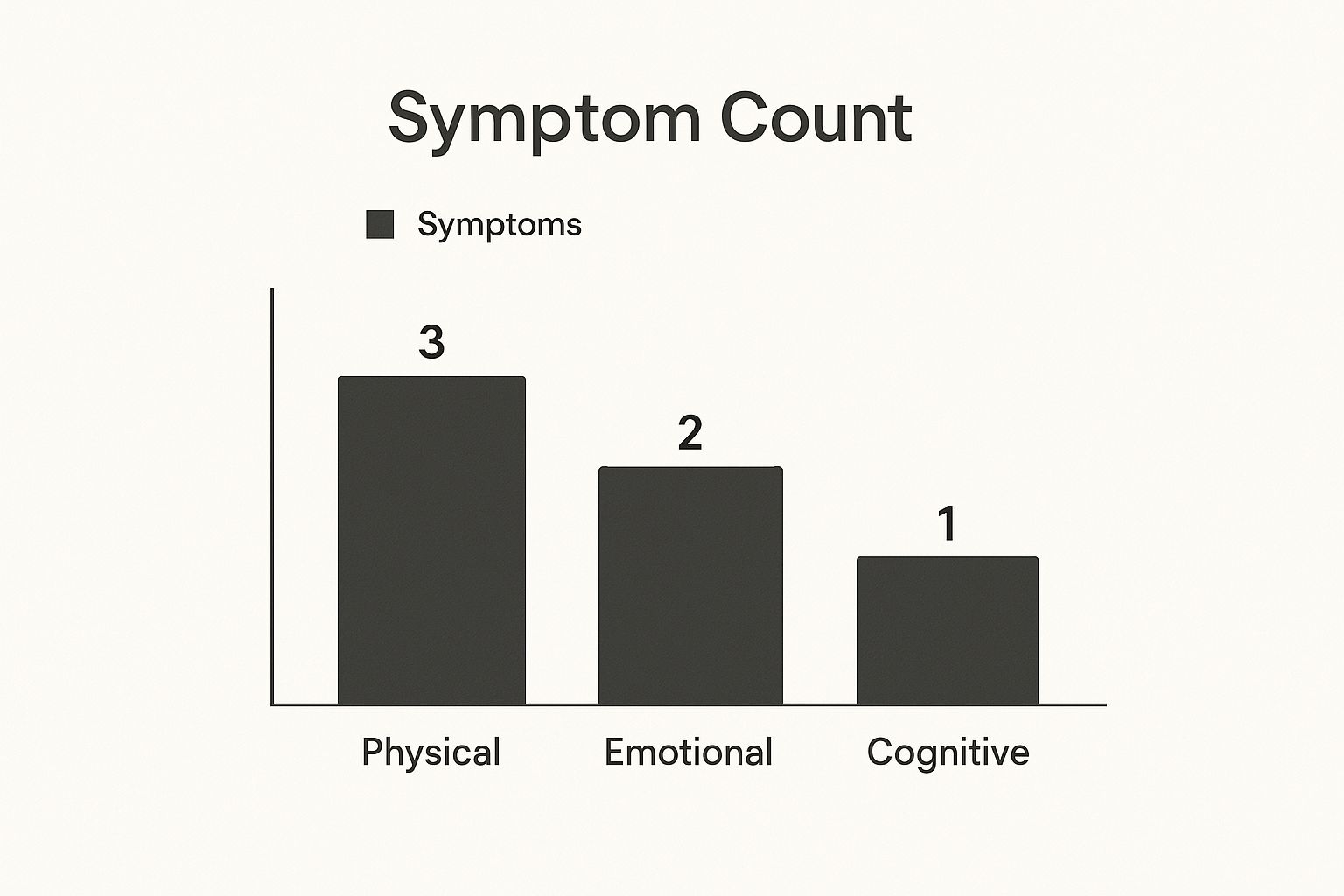When your body’s stress response gets stuck in the “on” position, you’re left feeling constantly wired, anxious, and exhausted—even when there’s no immediate danger. This is what we mean by an overstimulated nervous system. It’s a physiological state of high alert, driven by the demands of modern life that simply overwhelm your body's ability to return to a calm, balanced state.
Is Your Body's Alarm System Stuck On?

Think of your body’s internal operating system as having two primary modes. The first is your parasympathetic nervous system, which handles your "rest and digest" functions. This is your braking system, responsible for promoting calm, healing, and recovery.
The other mode is the sympathetic nervous system, which activates your "fight or flight" response. This is your gas pedal, designed to give you a powerful surge of energy to face a threat or a challenge.
In a healthy, balanced system, you transition smoothly between these two modes throughout the day. You hit the gas when you need to be sharp for a big presentation, but you’re able to apply the brakes afterward to relax and recover. An overstimulated nervous system, however, is like having your foot jammed on the gas pedal with no way to reach the brakes. Your internal alarm system is constantly blaring.
The Gas Pedal and the Brakes
Let's try another analogy. Imagine a hyper-sensitive home security system. A well-calibrated system only sounds the alarm when there's a genuine threat. But a faulty one might get triggered by a leaf blowing past the window or a cat jumping on the fence, screaming "DANGER!" at completely harmless events.
An overstimulated nervous system does the exact same thing. It reacts to everyday stressors—a frustrating email, a traffic jam, your child's tantrum—as if they were life-threatening emergencies. This state is known as sympathetic dominance. Your body is continuously flooded with stress hormones like cortisol and adrenaline, keeping your heart racing, muscles tense, and mind on high alert. This constant state of readiness was never meant for long-term use.
Why Modern Life Keeps the Gas Pedal Floored
Our bodies simply haven't evolved to handle the non-stop, low-grade stressors of contemporary life. The human nervous system is brilliant at handling acute, short-term threats, like escaping a predator. Where it struggles is with the chronic nature of today’s demands.
The biological stress response our bodies trigger when trying to get dinner on the table before a toddler meltdown is fundamentally the same as the one designed for escaping a lion.
When these moments happen over and over again without adequate rest, our system never gets the signal that the threat has passed. Before long, we find ourselves in a state where the "off" switch feels broken.
This chronic state of alert is exactly why you might feel:
- Wired but tired: Your mind is racing a million miles an hour, but your body is completely exhausted.
- Constantly on edge: You're easily startled or find yourself overreacting to small, insignificant issues.
- Unable to relax: Even during your downtime, you just can't seem to truly switch off and unwind.
Understanding this core imbalance is the crucial first step toward recognizing the specific symptoms in your own life and, more importantly, learning how to reclaim control over your body’s alarm system.
Recognizing the Signs of Nervous System Overload
When your internal alarm system is stuck in the "on" position, the effects show up all over your body, not just in your head. An overstimulated nervous system sends out distress signals that can appear as physical, emotional, and even cognitive issues. Learning to spot these signs is the very first step toward finding your way back to balance.
Often, these symptoms can feel completely disconnected. You might blame brain fog on a rough night's sleep or chalk up digestive problems to something you ate. But you might not realize that these seemingly random issues can all stem from the same root cause: a system stuck on high alert.
Physical Manifestations of Overload
Your body is an honest scorekeeper. When your sympathetic nervous system—your "fight-or-flight" response—is running the show, it pulls energy away from important background tasks like digestion and immune function. All that energy gets redirected to handle what your body perceives as a threat, leading to a whole cascade of physical symptoms.
Some of the most common physical signs include:
- Chronic Fatigue: This isn't just regular tiredness. It's that "wired but tired" feeling where you're completely exhausted, yet you can't seem to switch off and get real rest.
- Digestive Distress: With your "rest and digest" system on the back burner, issues like bloating, stomach pain, constipation, or diarrhea can become a regular occurrence.
- Muscle Tension and Pain: That nagging tension in your neck, shoulders, and jaw is a classic sign. Your muscles are basically braced for a fight that never actually happens.
This infographic gives a clear breakdown of the common symptom categories that pop up when the nervous system is working overtime.

As you can see, physical symptoms are often the most common and noticeable signs that your system is pushed way past its limits.
Emotional and Cognitive Symptoms
Beyond the physical toll, an overstimulated nervous system can seriously mess with your emotional state and mental clarity. It's almost impossible to feel calm, present, and focused when you're stuck in survival mode. Your brain is just too busy scanning for danger to handle higher-level thinking or keep your emotions in check.
When your body is on high alert, your mind is more likely to perceive threats everywhere. This is why a dysregulated nervous system is often the biological root of persistent anxiety and irritability.
This constant state of alert can create a ton of emotional and cognitive hurdles, making things that used to be easy feel overwhelming. For a deeper dive into what this state looks and feels like, you can explore the signs of nervous system dysregulation in our detailed guide.
To help you connect the dots, here’s a quick look at how these symptoms often show up in daily life.
Common Symptoms of an Overstimulated Nervous System
This table breaks down the common patterns you might notice across the physical, emotional, and cognitive categories. See if any of these feel familiar.
| Symptom Category | Common Manifestations | What It Feels Like in Daily Life |
|---|---|---|
| Physical | Chronic Fatigue, Digestive Issues, Muscle Tension, Headaches | Feeling "wired but tired," dealing with frequent stomach upset, or having constant aches in your neck and shoulders. |
| Emotional | Heightened Anxiety, Irritability, Mood Swings, Panic Attacks | Feeling constantly on edge, snapping at loved ones over little things, or getting overwhelmed to the point of panic. |
| Cognitive | Brain Fog, Poor Concentration, Difficulty Making Decisions | Struggling to focus, feeling mentally scattered, or finding it hard to remember simple things or make a choice. |
If this table resonates with you, it’s a strong signal that your nervous system is overloaded. Remember, these symptoms aren't character flaws—they're physiological responses from a system that needs support. By recognizing them for what they are, you can start shifting your focus from just managing individual issues to addressing the core imbalance.
The Hidden Causes of Modern Overstimulation

If you feel perpetually on edge, it’s not just in your head—it’s a very real, physiological response to a world that rarely has an "off" switch. The first step toward finding your calm is understanding what’s keeping your body’s alarm system constantly ringing. An overstimulated nervous system doesn't just appear out of nowhere; it’s the sum total of countless daily stressors we’ve started to accept as normal.
These modern stressors are like constant, low-grade threats. Even though an email notification isn't a tiger in the bushes, your body’s ancient survival wiring often struggles to tell the difference. Each little trigger adds another drop of fuel to the fire, keeping your sympathetic "fight or flight" response smoldering until it turns into a constant blaze.
The Digital Deluge
One of the biggest culprits behind nervous system overload is our non-stop digital connection. Every notification, email alert, and news headline is a tiny interruption that yanks your brain's attention away from what it was doing. This relentless flood of information hijacks your focus and locks your system into a state of high alert, always waiting for the next ping.
Even the light from our screens is part of the problem. The blue light from phones, tablets, and computers is known to suppress melatonin—the hormone that manages your sleep-wake cycles. This messes with your body's natural rhythm, making it tougher to wind down and get the restorative sleep that is so critical for nervous system recovery.
High-Pressure Environments and Unresolved Stress
It's not just our screens. Our work and personal lives often create the perfect storm for chronic stress. High-pressure jobs that celebrate being "always on" can make it feel impossible for your nervous system to ever shift into its "rest and digest" mode. You end up carrying that tension around all day, creating a new, stressful baseline.
On top of that, unresolved emotional stress from past events or ongoing conflicts acts like a heavy program running in the background, constantly draining your system's resources.
Think of your nervous system's capacity like a phone's battery. Every stressor—a work deadline, a family argument, financial worries—is an app running in the background. With too many apps open at once, the battery drains fast, leaving you depleted and struggling to function.
Identifying these hidden causes is incredibly empowering. It helps you see that you're not broken; your body is just having a normal reaction to an abnormal amount of stimulation. Once you start pinpointing the triggers, you can make targeted changes to lighten the load on your system.
These triggers usually fall into a few key categories:
- Sensory Overload: Constant background noise, harsh artificial lights, and crowded places can bombard your senses, pushing your nervous system into overdrive.
- Poor Nutrition: A diet loaded with processed foods, sugar, and caffeine can cause inflammation and blood sugar rollercoasters, both of which add more stress to your body.
- Sleep Deprivation: A lack of quality sleep might be the single biggest obstacle to a regulated nervous system. It robs your body of its essential time to repair, reset, and recharge.
Recognizing how these pieces of the puzzle affect you is the foundation for building resilience and finally giving your body the break it’s been begging for.
The Long-Term Health Risks of Staying Wired
Living with a stress response that’s always “on” is more than just draining—it’s a serious gamble with your long-term health. When your nervous system gets stuck in that “fight or flight” mode, it forces your body to operate under conditions it was never meant to sustain for long periods.
Over time, this chronic state of high alert starts to wear down your body’s most important systems, setting the stage for some significant health problems down the road.
Think of it like driving a car with the gas pedal pushed to the floor for weeks straight. The engine will eventually overheat, the tires will wear thin, and critical parts will start to fail. That's exactly what's happening inside your body when your sympathetic nervous system (SNS) is running the show 24/7. It's not a question of if problems will pop up, but when.
The Pressure Cooker Effect on Your Heart
One of the first and most well-documented consequences of a chronically overstimulated nervous system is the toll it takes on your cardiovascular health. When your SNS is activated, it floods your system with stress hormones that make your blood vessels tighten and your heart beat faster and harder.
This is a fantastic survival mechanism if you need a short burst of energy, but when it becomes your body's default state, it puts an immense strain on your entire cardiovascular system.
This constant pressure forces your heart to work overtime, day in and day out, which can lead to conditions like hypertension (high blood pressure). The link between an overactive SNS and high blood pressure isn’t a new idea, either. This connection was clinically recognized way back in the early 20th century. By 1935, surgeons were even performing procedures to sever sympathetic nerves to treat severe hypertension.
Today, with hypertension affecting over 1.4 billion people globally, understanding how it's connected to nervous system health is more critical than ever. You can explore the history and clinical importance of SNS overactivity in this detailed research on hypertension.
Fueling the Flames of Inflammation
Beyond your heart, a constantly overstimulated nervous system is a primary driver of chronic, body-wide inflammation. Your stress response and your immune system are deeply connected. When your body thinks it’s under constant threat, it keeps your immune system on high alert, ready to fight off invaders or heal injuries that might happen.
To do this, it releases pro-inflammatory molecules called cytokines. These are helpful in small, short-term doses for acute injuries, but a continuous flood of these chemicals creates a state of systemic inflammation.
"Chronic inflammation is now understood to be the common denominator in many age-related diseases. When the nervous system is chronically dysregulated, it essentially keeps the inflammatory 'on' switch flipped, contributing to the progression of numerous health conditions."
This low-grade, simmering inflammation is a key factor in the development and worsening of many chronic conditions, including:
- Autoimmune Diseases: For anyone with conditions like rheumatoid arthritis, lupus, or Hashimoto's, an overstimulated nervous system can trigger and intensify flare-ups by keeping the immune system in an aggressive, overactive state.
- Metabolic Disorders: Chronic inflammation messes with hormonal balance and insulin sensitivity, raising the risk of developing type 2 diabetes and metabolic syndrome.
- Neurodegenerative Conditions: New research is pointing to a strong link between chronic systemic inflammation and the health of the brain, potentially contributing to cognitive decline over time.
Recognizing these profound, body-wide impacts makes it clear why we need to address an overstimulated nervous system. It's not just about feeling better in the moment; it's a fundamental part of building long-term health. Taking steps now to regulate your internal alarm system is one of the most powerful investments you can make in your future well-being.
Actionable Strategies to Regulate Your Nervous System
Realizing you have an overstimulated nervous system is the first, crucial step. Learning how to gently guide it back to a place of safety is where the real change begins.
The goal isn't to get rid of stress entirely—that's impossible. Instead, it's about building your capacity to move out of that high-alert state and back into calm. This all comes down to actively engaging your parasympathetic nervous system, which acts as your body’s natural brake pedal.
The good news is that you have direct access to this system through simple, intentional actions. These aren't complicated medical treatments; they are practical, evidence-based techniques you can pull out of your back pocket anytime, anywhere to signal to your body that you are safe. By practicing these strategies, you can begin to restore balance and build lasting resilience.
Master Your Breath to Master Your Calm
Your breath is the single most powerful and immediate tool you have for shifting your nervous state. Slow, controlled breathing directly stimulates the vagus nerve, which is the main highway of your parasympathetic nervous system. When you deliberately slow down your breathing, you're sending a direct message to your brain that the danger has passed.
A ridiculously effective technique is the physiological sigh. It’s simple: take two quick inhales through the nose, then follow with one long, slow exhale through the mouth. Your body already does this naturally during sleep to offload carbon dioxide and reset your respiratory rhythm. You can consciously use it during the day to rapidly shut down feelings of stress and panic.
By taking conscious control of your breath, you are taking control of your nervous system. A simple physiological sigh can interrupt a rising wave of anxiety in under a minute, making it one of the fastest ways to downshift out of fight-or-flight.
Reconnect Through Gentle Movement and Nature
When your body is stuck on high alert, physical tension is almost always part of the package. Gentle, mindful movement is a fantastic way to release all that stored-up stress energy without accidentally revving up your sympathetic nervous system even more.
Instead of intense, heart-pounding exercise that can sometimes mimic the physical signs of a stress response (like a racing heart), try opting for more grounding activities.
- Mindful Walking: Really pay attention to the sensation of your feet hitting the ground and the rhythm of your breath as you walk.
- Gentle Stretching or Yoga: Focus on slow, deliberate movements that release tension in those classic stress spots like the neck, shoulders, and hips.
- Shaking or Dancing: It might sound silly, but simply shaking out your arms and legs or dancing to a favorite song is a powerful way to discharge nervous energy.
You can amplify the benefits by pairing this movement with time in nature. Research shows that spending time outdoors lowers cortisol levels and eases feelings of anxiety. This practice, sometimes called "earthing" or "grounding," involves direct physical contact with the earth—think walking barefoot on grass—which can be incredibly calming for an overstimulated system.
Engage Your Senses to Ground Yourself
When your mind is racing with anxious thoughts, grounding techniques that pull in your five senses can yank you out of those thought loops and back into the present moment. This simple process of intentional focus helps your nervous system realize that there is no immediate danger right here, right now.
An easy one to remember is the 5-4-3-2-1 technique:
- Acknowledge FIVE things you can see around you.
- Acknowledge FOUR things you can touch and actually feel their texture.
- Acknowledge THREE things you can hear in your environment.
- Acknowledge TWO things you can smell nearby.
- Acknowledge ONE thing you can taste.
These small, consistent actions are the building blocks of nervous system regulation. For those ready to go deeper, understanding the mechanisms behind these practices is key. You can learn more about how to activate your body's relaxation response through parasympathetic nervous system stimulation in our complete guide. By integrating these simple tools into your daily routine, you empower yourself to shift from a state of overwhelm to one of calm control.
How Chiropractic Care Can Help Restore Balance

While lifestyle changes are a huge piece of the puzzle, sometimes you need a more direct approach to calm a nervous system that's stuck on high alert. This is where neurologically-focused chiropractic care comes in. It offers a powerful, hands-on way to address the physical stress patterns that keep your body locked in survival mode.
Think of your spine as the superhighway for your entire nervous system. Every single signal traveling from your brain out to your body—and from your body back to your brain—has to pass through this critical structure. When everything is aligned and moving well, that communication network is fast, clear, and efficient.
But life happens. Physical, chemical, and emotional stressors can create tiny misalignments in the spine, which we call subluxations. These might seem small, but they create interference along that superhighway—think of it like static on a phone line, garbling the messages between your brain and body.
This static is a major contributor to a state of sympathetic dominance, where your "fight or flight" response becomes your default setting. In essence, the physical tension from a misaligned spine constantly sends "danger!" signals to your brain, even when you're perfectly safe.
Restoring Clear Communication
A neurologically-focused chiropractor uses incredibly gentle and specific adjustments to correct these subluxations. The goal isn’t just about cracking a sore back; it's about reducing that static and interference within the nervous system. By restoring proper alignment and motion, the adjustments help turn down the volume on those constant stress signals.
This process gives your body a chance to shift out of that overstimulated state and back toward a natural balance. Once the static clears, your brain gets a much more accurate picture of what's really going on, allowing your parasympathetic "rest and digest" system to finally take the lead.
To really dive into this, you can learn more about the direct relationship between chiropractic care and the nervous system.
An adjustment acts like a reset button for your body's internal communication system. It calms the frantic signaling that keeps you on edge, creating the space for your body to return to a state of safety and ease.
Measuring the Change in Your Nervous System
So, how can we actually see this change happening? One of the best tools we have for tracking nervous system balance is Heart Rate Variability (HRV). HRV measures the tiny variations in time between each heartbeat, and it gives us a direct window into how well your body is adapting to stress.
- Low HRV is linked to a dominant "fight or flight" response. It shows your system is under strain and isn't very resilient.
- High HRV signals a well-balanced, adaptable nervous system with a strong "rest and digest" tone. This is a key indicator of good health and resilience.
Research has shown that consistent chiropractic care can lead to significant improvements in HRV. By reducing interference along the spine, adjustments improve the function of the vagus nerve—the main controller of your parasympathetic system. This boost in function makes your body more resilient, helping it bounce back from stress faster and spend more time in that calm, regulated state we're all aiming for.
Frequently Asked Questions About Nervous System Regulation
Even after you start to recognize the signs of an overloaded nervous system, a lot of practical questions can pop up. Finding your way back to a state of balance is a journey of curiosity and patience, and having clear answers can make it all feel less overwhelming. This section tackles some of the most common questions we hear about calming an overstimulated nervous system.
We’ll dig into realistic timelines for recovery, the huge role diet plays, and the critical difference between the physical state of an overstimulated system and the emotional feeling of anxiety.
How Long Does It Take to Calm an Overstimulated Nervous System?
Honestly, there's no one-size-fits-all answer—the time it takes is unique to you. If you’re dealing with a sudden, sharp spike of stress, a simple tool like the physiological sigh can bring you back down in just a few minutes by hitting the brakes on that "fight or flight" response.
But for a chronically overstimulated nervous system, the recovery process is much more of a marathon than a sprint. We're talking weeks or even months of consistent, daily practice. Real, lasting change comes from both using calming techniques and getting to the root of the problem, whether that's chronic stress, old trauma, or just terrible sleep habits. Remember, it’s the small things you do every day that add up to big results, not the occasional heroic effort.
Can Diet and Supplements Make a Real Difference?
Absolutely. Think of your diet as the raw material your body uses to build a healthy, resilient nervous system. What you eat can either help your body regulate itself or actively work against it.
Your nervous system can't run on fumes. Inflammatory foods like processed sugars, industrial seed oils, and too much caffeine act like a constant, low-level stressor, making it that much harder for your system to ever find its way back to calm.
A diet packed with whole foods gives your body the nutrients it needs to find balance. Some key players include:
- Omega-3 Fatty Acids: Found in fatty fish like salmon, these are essential for brain health and keeping inflammation in check.
- Magnesium: Often called the "calming mineral," it’s crucial for regulating neurotransmitters. You can find it in leafy greens, nuts, and seeds.
- B Vitamins: These are your nervous system's best friends, vital for energy and overall function.
While supplements like magnesium glycinate or L-theanine can offer extra support, it's always best to chat with a healthcare professional before adding anything new to your routine to make sure it’s a good fit for you.
What Is the Difference Between Anxiety and an Overstimulated Nervous System?
This is a great question. While they are deeply intertwined, they aren't the same thing. An overstimulated nervous system is a physiological state—it means your body's "fight or flight" alarm is stuck in the "on" position.
Anxiety, on the other hand, is mostly an emotional and cognitive response. It’s the worry, unease, and fear you feel, often about what might happen in the future.
A dysregulated nervous system is very often the biological root of anxiety. When your body is on constant high alert, it makes perfect sense that your mind starts scanning for threats and spinning up anxious thoughts. But it's also possible to have an overstimulated system where the main symptoms are physical—like digestive upset or crushing fatigue—without feeling particularly anxious. The key takeaway is that to truly manage either, you have to address the underlying physical state first.
At First Steps Chiropractic, we specialize in getting to the bottom of nervous system dysregulation. Our neurologically-focused approach is all about restoring your body's innate ability to adapt, regulate, and heal itself. If you're tired of living in a state of constant stress and are ready to build resilience and well-being, schedule a complimentary consultation with us today.

